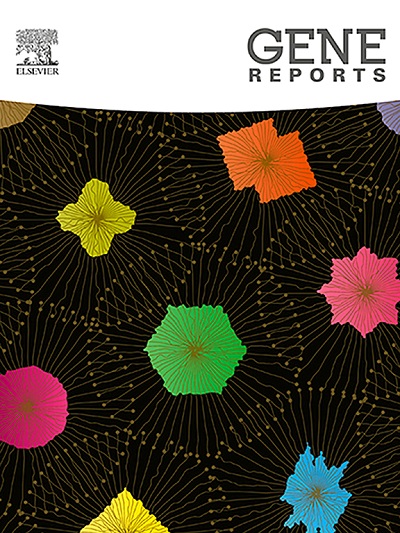利用全外显子测序鉴定八名股骨短小胎儿的基因突变
IF 1
Q4 GENETICS & HEREDITY
引用次数: 0
摘要
背景股骨长度是评估胎儿生长发育的重要指标之一。股骨短是一种常见的产前超声检查结果。本研究旨在利用基于三重外显子组的全外显子组测序(WES)研究胎儿股骨短小的遗传学病因,从而为产前诊断提供证据,并评估三重外显子组测序在胎儿股骨短小产前诊断中的应用。WES结果通过桑格测序进行了验证。对突变的致病性进行了评估。进行了迷你基因检测,以研究内含子突变对 mRNA 剪接的影响。结果 8例短股骨胎儿中共检测到7个基因突变。其中,COL2A1(p.Gly1107Glu)、GNAS(p.Lys739Glu)和FGFR3(c.1075 + 95C>G)是从未报道过的新型突变。结论本研究结果丰富了COL2A1、GNAS和FGFR3基因的突变谱,证明了三重WES在股骨短小胎儿产前诊断中的价值。本文章由计算机程序翻译,如有差异,请以英文原文为准。
Identification of mutations using whole exome sequencing in eight fetuses presenting with short femur
Background
Femur length is one of the important indicators for evaluating fetal growth and development. Short femur is a common prenatal ultrasound finding. This study aimed to investigate the genetic etiology of fetal short femur using trio-based whole exome sequencing (WES), so as to provide evidence for prenatal diagnosis and evaluate the application of trio-WES in prenatal diagnosis of fetal short femur.
Methods
We retrospectively analyzed the clinical phenotype and WES results of eight fetuses with short femur diagnosed by prenatal ultrasound. The results of WES were validated by Sanger sequencing. The pathogenicity of the mutations was evaluated. Minigene assay was performed to investigate the effects of intronic mutation on mRNA splicing. The pregnancy outcome was followed up.
Results
A total of seven mutations were detected in eight short femur fetuses. Among them, COL2A1 (p.Gly1107Glu), GNAS (p.Lys739Glu) and FGFR3 (c.1075 + 95C > G) were novel mutations that had not been reported. Minigene assay showed that c.1075 + 95C > G in FGFR3 partially retained a 90 bp sequence in intron 8.
Conclusions
The results of this study enriched the mutant spectrums of COL2A1, GNAS and FGFR3 genes, and demonstrated the value of trio-WES in prenatal diagnosis of fetuses with short femur.
求助全文
通过发布文献求助,成功后即可免费获取论文全文。
去求助
来源期刊

Gene Reports
Biochemistry, Genetics and Molecular Biology-Genetics
CiteScore
3.30
自引率
7.70%
发文量
246
审稿时长
49 days
期刊介绍:
Gene Reports publishes papers that focus on the regulation, expression, function and evolution of genes in all biological contexts, including all prokaryotic and eukaryotic organisms, as well as viruses. Gene Reports strives to be a very diverse journal and topics in all fields will be considered for publication. Although not limited to the following, some general topics include: DNA Organization, Replication & Evolution -Focus on genomic DNA (chromosomal organization, comparative genomics, DNA replication, DNA repair, mobile DNA, mitochondrial DNA, chloroplast DNA). Expression & Function - Focus on functional RNAs (microRNAs, tRNAs, rRNAs, mRNA splicing, alternative polyadenylation) Regulation - Focus on processes that mediate gene-read out (epigenetics, chromatin, histone code, transcription, translation, protein degradation). Cell Signaling - Focus on mechanisms that control information flow into the nucleus to control gene expression (kinase and phosphatase pathways controlled by extra-cellular ligands, Wnt, Notch, TGFbeta/BMPs, FGFs, IGFs etc.) Profiling of gene expression and genetic variation - Focus on high throughput approaches (e.g., DeepSeq, ChIP-Seq, Affymetrix microarrays, proteomics) that define gene regulatory circuitry, molecular pathways and protein/protein networks. Genetics - Focus on development in model organisms (e.g., mouse, frog, fruit fly, worm), human genetic variation, population genetics, as well as agricultural and veterinary genetics. Molecular Pathology & Regenerative Medicine - Focus on the deregulation of molecular processes in human diseases and mechanisms supporting regeneration of tissues through pluripotent or multipotent stem cells.
 求助内容:
求助内容: 应助结果提醒方式:
应助结果提醒方式:


